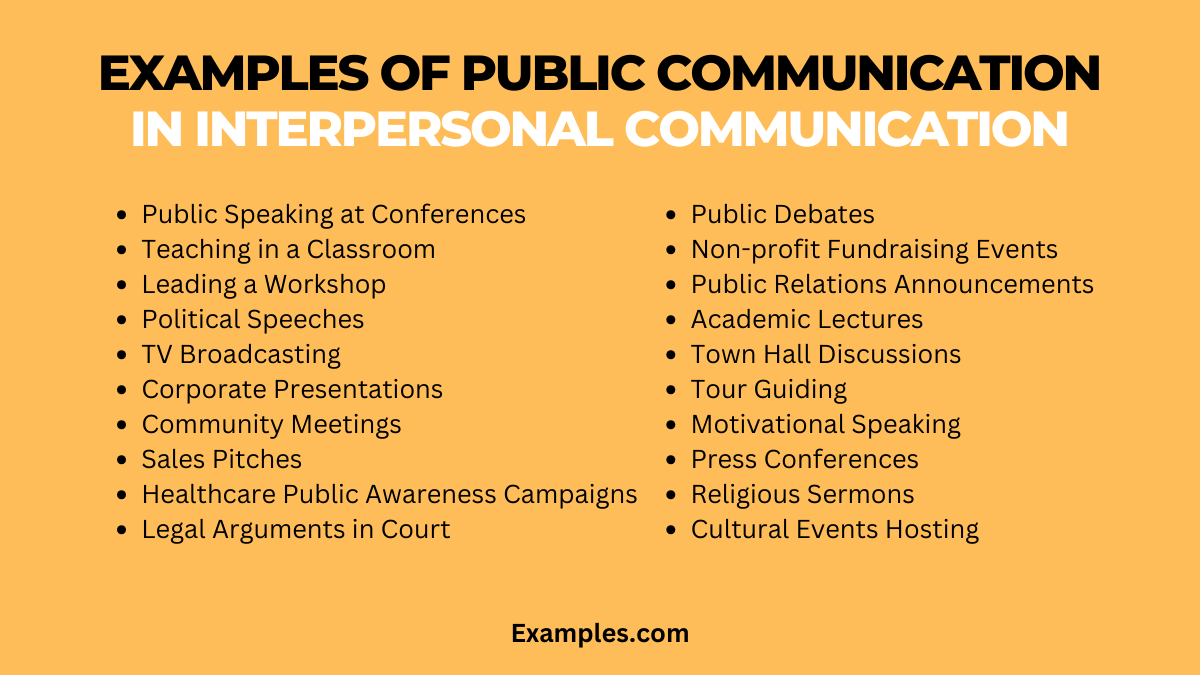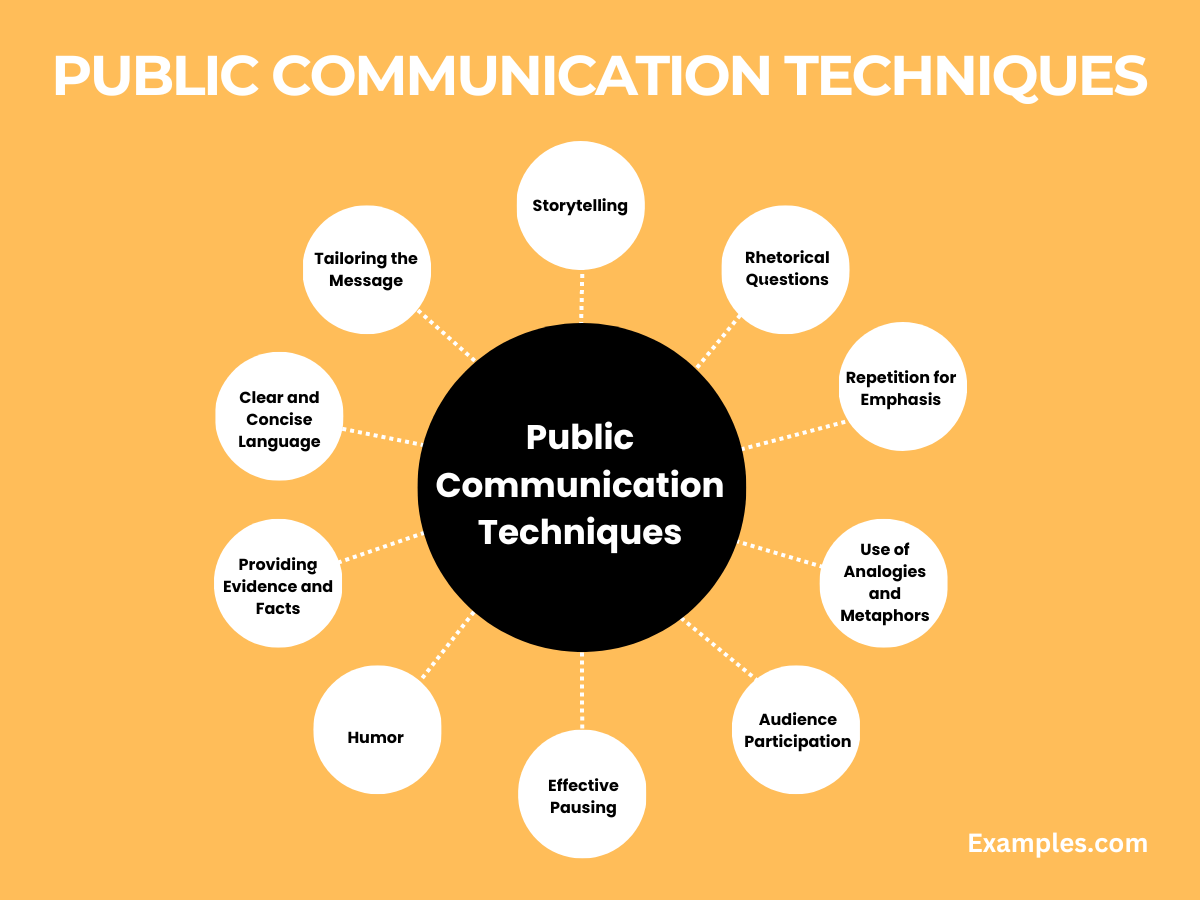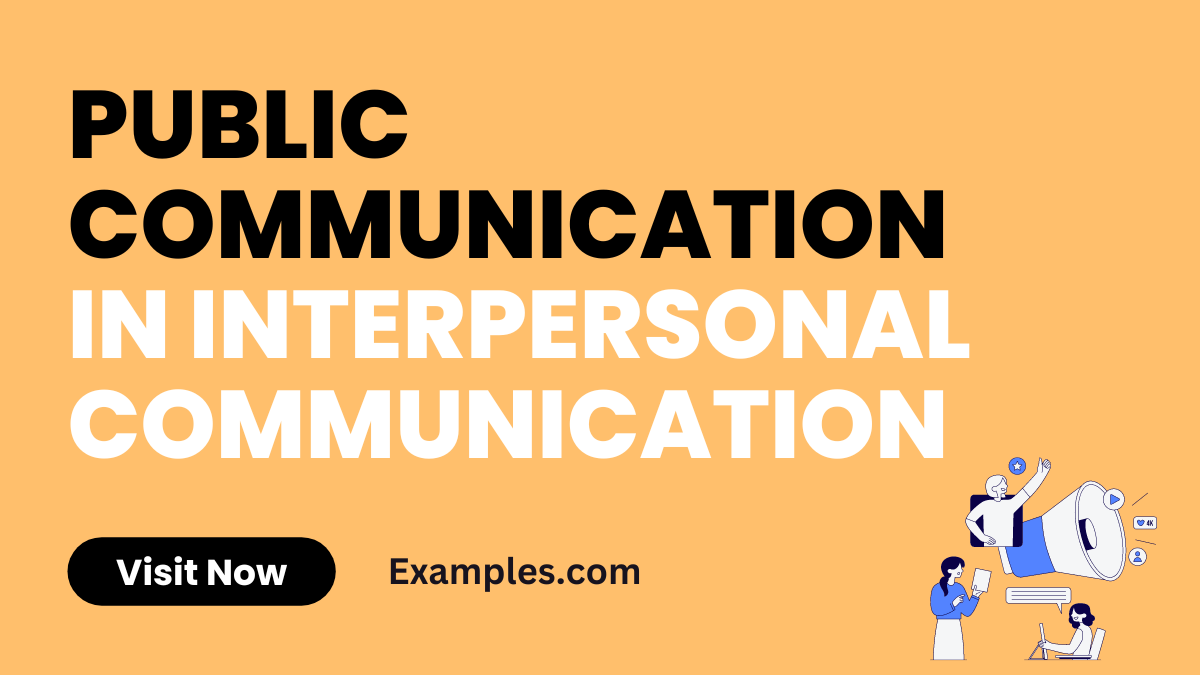19+ Public Communication in Interpersonal Communication Examples
Public Communication plays a pivotal role in interpersonal interactions. It’s not just about speaking in front of a crowd, but about effectively conveying your message in various social settings. This guide delves into the nuances of public communication within the realm of interpersonal relationships. We will explore Interpersonal Communication Examples that highlight the impact of public speaking skills on personal and professional interactions. From presenting ideas in meetings to engaging in community discussions, public communication is an essential tool for anyone looking to enhance their interpersonal skills. Learn how to use verbal and non-verbal cues effectively, how to engage your audience, and how to leave a lasting impression in every conversation.
What is Public Communication in Interpersonal Communication?

Public communication in the context of interpersonal communication refers to the process of exchanging information and ideas in a public setting, involving more than just one-on-one interactions. This form of communication often occurs in settings like meetings, group discussions, presentations, or public speaking events. It requires not only the ability to convey a message effectively to a larger audience but also to understand and respond to the audience’s feedback, whether it be verbal or non-verbal. The key to successful public communication in interpersonal settings lies in the clarity of the message, the ability to engage the audience, and the proficiency in adapting the communication style to suit the context and audience.
What is the Best Example of Public Communication in Interpersonal Communication?
The best example of public communication in interpersonal communication can be seen in group discussions or team meetings. Here, an individual needs to present their ideas or opinions to a group effectively. This scenario requires not only the clear articulation of thoughts (Verbal Communication in Interpersonal Communication) but also the ability to read the room, understand non-verbal cues (Non-Verbal Communication in Interpersonal Communication), and respond to feedback constructively. In such settings, an effective communicator employs active listening, clear expression, and empathy to ensure that their message is not only heard but also understood and appreciated by the audience. This type of communication demonstrates the ability to influence, persuade, and engage multiple individuals simultaneously, making it a quintessential example of public communication in interpersonal contexts.
20 Examples of Public Communication in Interpersonal Communication

Public communication in interpersonal communication is an essential aspect of conveying messages and ideas effectively in a public setting. This form of communication often involves verbal communication and non-verbal communication skills to address an audience effectively, ensuring the message is clear, engaging, and impactful. Here are 20 examples with brief descriptions and communication sentences.
- Public Speaking at Conferences: In a conference setting, convey your message with confidence and clarity.
Example: “Today, I’ll share insights on the latest trends in our industry.” - Teaching in a Classroom: Educators must communicate information clearly and interactively.
Example: “Let’s explore this concept through a group activity.” - Leading a Workshop: Facilitators should engage participants with interactive communication.
Example: “I encourage you all to participate in this hands-on session.” - Political Speeches: Politicians use persuasive language to influence and inform the public.
Example: “My vision for our community focuses on growth and prosperity.” - TV Broadcasting: TV hosts communicate with a wider audience using a mix of verbal and visual cues.
Example: “Tonight, we delve into the heart of this pressing issue.” - Corporate Presentations: Business professionals present ideas or updates compellingly.
Example: “This strategy will enhance our market position significantly.” - Community Meetings: Open and transparent communication fosters community engagement.
Example: “Let’s discuss our neighborhood development plans.” - Sales Pitches: Salespeople use persuasive and clear language to attract customers.
Example: “Our product uniquely solves your current challenges.” - Healthcare Public Awareness Campaigns: Healthcare professionals inform the public about health issues.
Example: “Understanding this health risk can save lives.” - Legal Arguments in Court: Lawyers articulate their points clearly and logically.
Example: “The evidence clearly points to my client’s innocence.” - Public Debates: Debaters use logical and persuasive arguments.
Example: “Let me outline why this policy benefits our society.” - Non-profit Fundraising Events: Charismatic communication is key to inspiring donations.
Example: “Your support can transform lives in meaningful ways.” - Public Relations Announcements: PR professionals craft messages to shape public perception.
Example: “Our company is committed to sustainable practices.” - Academic Lectures: Professors impart knowledge using engaging and informative speech.
Example: “This theory revolutionized our understanding of the subject.” - Town Hall Discussions: Open dialogue between officials and citizens.
Example: “We value your input in shaping our town’s future.” - Tour Guiding: Guides provide information in an engaging and informative manner.
Example: “This landmark has a fascinating historical significance.” - Motivational Speaking: Speakers inspire audiences with persuasive and uplifting messages.
Example: “Embrace challenges as opportunities for growth.” - Press Conferences: Effective communication is crucial for conveying accurate information.
Example: “We are here to provide the latest updates on the situation.” - Religious Sermons: Religious leaders share teachings and insights.
Example: “Today’s message focuses on compassion and community.” - Cultural Events Hosting: Hosts engage audiences with relevant and entertaining content.
Example: “Welcome to a celebration of our rich cultural heritage.”
Importance of Public Communication in Interpersonal Communication
Public communication plays a pivotal role in the broader spectrum of interpersonal communication. Understanding its importance is crucial in developing effective communication strategies in various social, professional, and public settings.
- Enhances Persuasive Skills: Public communication is a key component in honing persuasive skills. It teaches individuals how to influence and motivate others, a vital aspect of interpersonal interactions.
- Builds Confidence: Regular engagement in public communication builds confidence in expressing ideas and opinions, which is essential for effective interpersonal communication.
- Improves Clarity and Articulation: Public speaking demands clarity and the ability to articulate thoughts coherently, skills that are directly transferable to one-on-one interactions.
- Facilitates Better Understanding of Audience Dynamics: Understanding diverse audiences in public communication scenarios improves the ability to adapt messages for different interpersonal contexts.
- Develops Active Listening Skills: Effective public communication is not just about speaking but also involves active listening, an essential component of interpersonal communication skills.
- Enhances Non-Verbal Communication Skills: Public communication involves a significant amount of non-verbal cues, which play a critical role in interpersonal communication.
- Promotes Empathy and Emotional Intelligence: Engaging with a wide range of audiences enhances empathy and emotional intelligence, key aspects of interpersonal relations.
- Cultivates Critical Thinking and Problem-Solving: Public communication often involves addressing complex topics, fostering critical thinking and problem-solving skills useful in interpersonal settings.
- Improves Adaptability and Flexibility: Adapting speeches to different audiences and contexts in public communication fosters adaptability, a trait beneficial in personal interactions.
- Encourages Feedback Reception and Integration: Public communication often involves receiving and integrating feedback, a practice that enhances interpersonal communication by fostering openness and adaptability.
Types of Public Communication Techniques in Interpersonal Communication

1. Storytelling
Storytelling in public communication is a powerful technique for creating relatable and memorable messages. It involves weaving facts and information into narratives that resonate on a personal level, enhancing interpersonal connections.
2. Rhetorical Questions
Rhetorical questions engage the audience and provoke thought, making them effective in both public and interpersonal communication for emphasizing points and stimulating reflection.
3. Repetition for Emphasis
Repeating key phrases or ideas can reinforce messages in the minds of the audience, a technique equally effective in one-on-one conversations to highlight important points.
4. Use of Analogies and Metaphors
Analogies and metaphors simplify complex ideas and make them relatable, which is crucial in both public speaking and interpersonal interactions for clear and effective communication.
5. Audience Participation
Inviting audience participation in public communication settings fosters interaction and engagement, similar to encouraging dialogue in interpersonal communication.
6. Effective Pausing
Strategic pausing in public communication gives the audience time to absorb information, a technique that can be mirrored in interpersonal communication to enhance understanding and connection.
7. Humor
Humor lightens the mood and increases engagement in public speaking, and when used appropriately, can similarly enhance interpersonal interactions.
8. Providing Evidence and Facts
Backing up statements with evidence and facts builds credibility in public communication and is equally important in interpersonal communication to establish trust.
9. Clear and Concise Language
Using clear and concise language is fundamental in public communication and is equally critical in interpersonal communication to ensure the message is understood.
10. Tailoring the Message
Customizing the message to suit the audience in public communication is akin to adapting communication styles in interpersonal interactions to better connect with the individual or group.
Incorporating these public communication techniques into interpersonal communication can significantly enhance the effectiveness and impact of personal interactions. Whether in professional settings or personal relationships, mastering these skills leads to more meaningful and productive communications.
Mastering public communication within interpersonal contexts is not just about speaking eloquently in front of an audience. It’s about engaging with empathy, clarity, and adaptability. Whether in a boardroom, classroom, or community gathering, effective public communication enhances interpersonal relationships, fosters understanding, and builds stronger connections. As we navigate various social and professional settings, the skills honed in public communication become invaluable tools in our interpersonal communication arsenal.
For further exploration into the nuances of effective public communication, the Harvard Business Review offers insightful articles and resources. Additionally, for those interested in delving deeper into interpersonal communication dynamics, Psychology Today provides a wealth of information on the psychological aspects of communication, both public and interpersonal. These resources provide valuable perspectives and strategies to enhance our communication skills in all areas of life.



